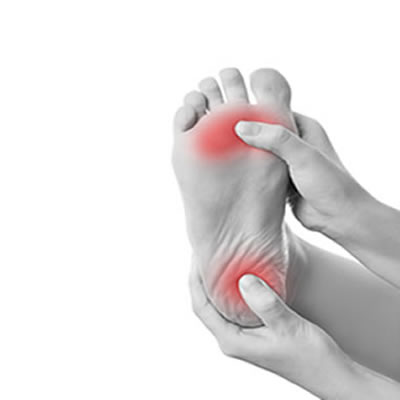What We Treat
Chiropractic treatments is effective for a wide variety of conditions. The following is a partial list of some of the most common. If you do not see your specific condition listed, we encourage you to give us a call so we can personally address your particular concerns.
Back and neck pain are among the most common of chronic ailments. So many factors are involved in pain in these areas, that establishing an exact cause is not always straightforward. One factor, however, is the complex structure of the spinal column. Also known as the vertebral column, it consists of thirty-three small bones or vertebrae. The arrangement of these bones defines the structure of the body and protects the spinal cord or network of nerves that connect directly with the brain. The interlinked vertebrae are separated by cartilage discs that add flexibility to the spine and help prevent injury. Occasionally, one or more of these discs slips out of place, causing what we call the “slipped disc”.
The knee is primarily a hinge joint for the lower limb, serving as leaver mechanism to allow efficient movement and shock absorption.
Knee pain can occur from direct trauma or repetitive use and can also be referred from other sources i.e. the hip or lower back. Poor mechanics or problems at the hip or ankle are often “off loaded” or compensated for at the knee. This often results in knee pain with the cause being above and/or below the knee.
Chiropractic treatment encompasses both the treatment of the damaged or dysfunctional tissues but also looks at why the injury occurred in the first place. Typically a patient will receive hands on treatment to correct the altered movement in the knee and be guided in specific strengthening and conditioning programmes tailored to fit your individual lifestyle.
Pain radiating from the low back, through the buttocks and into the legs is commonly referred to as being ‘sciatic’. The sciatic nerve is the largest nerve in the body and courses down into each leg to supply many of the tissues (specifically, it controls the muscles of the lower leg and back of the knee and provides sensation to the back of the thigh, part of the lower leg, and the sole of the foot). Therefore if the nerve is inflamed or compressed it can lead to the pain, weakness or numbness that typically affect sciatica sufferers.
The structures involved may be overly taut muscles, damaged intervertebral discs, arthritic joints and numerous other causes. Sciatic-type pain can also be mimicked by many structures within the lumbar spine (low back), resulting in referred pain down into the buttocks or legs. It is therefore important to accurately diagnose the source of the pain in order to specifically tailor the treatment.
The glenohumeral joint more commonly known as the shoulder joint is a very common area for pain and discomfort and in order to resolve the symptoms is important to obtain a correct diagnosis. The shoulder is a ball and socket joint and has a very wide range of motion which can often lead the shoulder prone to overuse and trauma. The shoulder therefore relies heavily on a group of muscles known as the SITS muscles or rotator cuff muscles to stabilise the joint.
Following injury the strength and function of these muscles can be affected resulting in muscle imbalance which unless addressed can lead to chronic pain and loss of movement of the joint. Posture and ergonomics have a significant role to play in common shoulder complaints such as poor posture, incorrect work station set up and repetitive overuse.
Because many of us experience the odd headache every now and again, it can be easy to view them as “normal” or something you have to “live with”. However, headaches can be very debilitating, in fact research has shown that severe headaches like migraine have such an impact on an individual’s quality of life that is greater than the effect of notable chronic conditions such as osteoarthritis, hypertension and diabetes.
Neck pain is a very common complaint, and something that the vast majority of people will experience at least once. Anyone who has experienced it already will know that the amount of pain at any given moment can vary greatly- one minute it might be very mild, whereas the next it might be excruciating.
The biological cause of neck pain is in most cases due to muscular spasms, ligament sprains, and injuries to the discs which make up the neck itself.
Have you ever considered the amazing complexity that the human foot requires in order to control motion, provide feedback for balance, maintain stability AND absorb ground impact forces all whilst under the full load of the body? It achieves this through an intricate structure comprising 33 joints, 107 ligaments, 19 muscles and 10 tendons within each foot.
Amazingly, approximately a third of all the bones in the body are located within our feet. As we move, the foot and ankle must maintain both mobility and stability. This compromise makes this area particularly vulnerable to injury, for example sprains, tendinosis and fasciitis. In addition, dysfunction in the mechanics and control of the feet can exacerbate problems through the lower limb and even to the lower back or further.
Chiropractic treatment during pregnancy is considered a safe and effective means of treating common musculoskeletal symptoms that many pregnant patients encounter. Musculoskeletal changes occur during pregnancy due to the weight gain and hormonal changes which occur in the body. These changes commonly lead to problems such as low back and neck pain.
Chiropractors have a number of safe and gentle techniques which they can utilise with pregnant patients and alongside treatment we can offer advice on posture, exercise and diet. We can provide postural advice specific to your stage in pregnancy and exercises and stretches which you can perform at home.

SCOLIOSIS
Often, scoliosis is a condition that is present from birth, and can be cured only by surgery. However, other factors can cause an “s” or “c” bend in the spinal cord, for example, an irregularity in the skeleton that leads to spinal bias over time. Other common symptoms of poor spinal alignment include numbness and tingling in the hands, legs and feet, a sensation caused by spinal discs compressing and trapping nerves.
Better posture and sleeping position can help to minimise all of these symptoms. It is the lateral curvature of the spine that occurs most commonly during a person’s growth spurt before puberty.
When a normal spine is view from either the front or the back, the spine will appear to be to be straight. However, a patient suffering from scoliosis would have their spine (when viewed from either the front or the back) showing mild to severe abnormal curvature of their spine.
The wrist and hand require a great degree of movement and control to provide the complex and fine movements we use on a day-to-day basis. The wrist acts to allow positioning of the hand around a wide range of movements, this enables the fine motor control movements of the hand to be adapted to various tasks.
This adaptability is achieved with a combination of multiple small bones that make up the wrist and hand with the absence of bulky muscular support across the joints of the wrist and small muscles at the hand.
Reliance on stability at the wrist is placed on the ligaments and tendons that cross this area. As a result the wrist is prone to overload from repetitive activities and more vulnerable to direct impact than other joints in the body with greater muscular support.
Plantar fasciitis is one of the most common conditions causing heel pain. It involves inflammation of the plantar fascia — a tough, fibrous band of tissue that runs along the sole of the foot. The plantar fascia attaches to the heel bone (calcaneus) and to the base of the toes. It helps support the arch of the foot and has an important role in normal foot mechanics during walking.
Tension or stress in the plantar fascia increases when you place weight on the foot, such as withstanding. The tension also increases when you push off on the ball of the foot and toes. Both of these motions occur during normal walking or running. With overuse or in time, the fascia loses some of its elasticity or resilience and can become irritated with routine daily activities.









